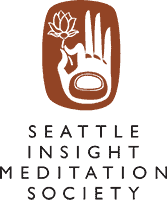See all series | See all talks
Teacher: Rodney Smith
Date: 2015-05-12
Venue: Seattle Insight Meditation Center
Series
- Continua of Practice 2015-05-12
Description
This new series will work with the continua of practice that form the basic ways we understand our spiritual journey. It would be very helpful if everyone would start by reading Awakening: A Paradigm Shift of the Heart (Shambhala 2014). Chapter Six is specific to this first talk. A continuum is a story or narrative about awakening. Myths are spiritual narratives that can usually be condensed into a continuum. There is a beginning and an end with various highs and lows throughout the process. An important point is that though a continuum is depicted as a linear journey, it is not a timeline, though from the perspective of the individual it may seem like it is. Many events take place on the horizontal line, and it can take a considerable amount of time to cross from one side to the other, but there is actually no separation between the two end points of the pathway. The mind fictitiously creates the time needed to cross, but the objective is always at hand. One of the paradoxes of any spiritual journey is that the infinite (the far right side) is always embracing the limited (the far left side), but the limited cannot feel that embrace. The sense-of-self wears the blinders of its own thoughts and that prohibits the wider gaze necessary to see the infinite. The path provides the opportunity to see the infinite by refocusing the individual’s attention away from the all-consuming narrative that defines and limits his life. Let us look briefly at the way I have sectioned the continuum below.
False Nirvana: The movement of the path is straightforward. Following the Buddha’s teaching, the journey is going from struggle (suffering) or self-centeredness to the end of struggle or connection and non-separation. This example of suffering and its end will be explored in more depth later in the series. Many of us enter our path with an objective to relieve part of our suffering, usually the most weighted issue in our lives such as self-dislike or an emotionally noisy mind. A false nirvana is a partial relief from the burden of that central issue that can be mistaken as a complete reprieve from the burden of suffering. What makes it nirvana is that a deeply wounded place within us is temporarily eased, and for once in our life we are no longer under the pain of its oppression.
Counter-Influence: Up until now we have been using time and distance as a valid way to proceed. “I am here and need to be there, and I would like it to happen soon.” At a certain point on the continuum, we understand that thinking in terms of time and distance moves the sense-of-self right along with us on the path. The below continuum suggests that we monitor whatever actions we are taking in body, speech, and mind in relationship to the struggle we bring to those tasks. Struggle or suffering is the surest sign of left-sided dominance and the most obvious way to know when we are under the ego’s influence. I label this on the graph as “counter-influence” which means at this point on our journey we understand that the intrusion of the ego’s will on the direction we are heading is no longer useful – it is “counter-influential”. This is a huge shift since up until now we have been governed by our volitional efforts. Now we realize that any willful force that we think moves us toward the right side, adds to the overall struggle and therefore ultimately moves us to the left.
Paradigm Shift: As we relax deeply and begin to release our struggles, we may suddenly and unexpectedly enter a new paradigm, which abruptly shifts the figure/ground of our life. Up until this moment, we have always been front-and-center with the world funneling through our reasoning, now we see ourselves being birthed moment to moment by the infinite, held by the infinite, and an extension of it. We immediately understand the sense-of-I was always and only an idea believed – an idea arising from the infinite. Once this is seen there is no debate, no argument that counters the realization. We know this is how it has always been, and more to the point of the continuum, in the moment seen, there is no suffering. This cosmic shift can actually occur at any time throughout the continuum completely serendipitously. I believe this realization is much more common than we imagine, but having this recognition is not an end, it is how fully we allow it to transform us that is the key element for reaching the end of suffering.If we look at the diagram above we will see this shift does not end the continuum. At this point though there is nothing more to do, but to complete the continuum, this shift has to be embodied, and the spiritual path changes accordingly.
Homework
Work with the continuum below within your own practice. Have you experienced the cathartic realization of the false nirvana? Have you reached the point, called the counter-influence, where the sense-of-self is more intrusive than helpful? Has there been a paradigm shift, which is a shift of identity, out of the sense-of-I?
| False Nirvana | Paradigm Shift | |||
|
Divided Mind |
———|———————–|———————-|———— |
Unified Mind |
||
| Counter-influence | ||||
Video
Link to view on Vimeo: https://vimeo.com/127727382
TalkID=265 SeriesID=61

